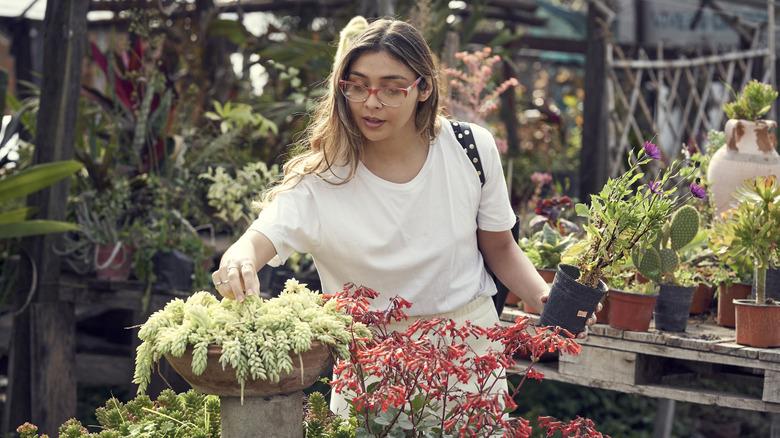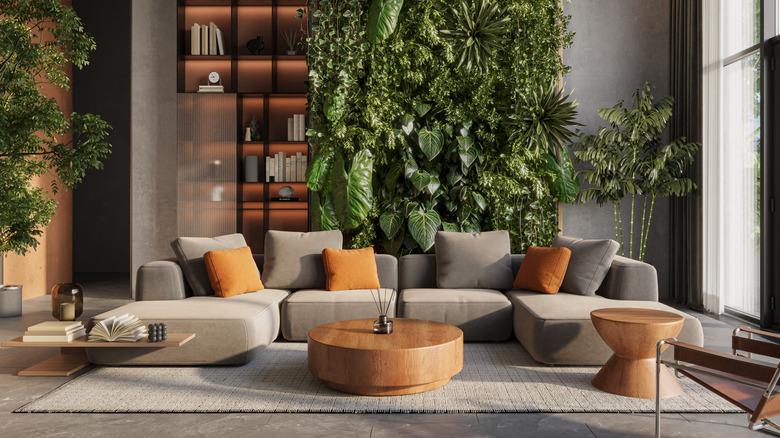The Formerly Favored Plant Trend That's Now Outdated, According To Our Designer
Let's be honest, we millennials love our plants. In the same way Edison bulbs hung bare from every cafe ceiling and every wall was painted a soft, cool gray in the 2010s, we started putting plants on everything — including on vertical surfaces to create living walls. While this trend of large-scale vertical plant displays started, and logically felt at home, in outdoor spaces, the adoration of houseplants by everyone in our generation, who were now newly living in our own spaces, meant the trend quickly made its way indoors. Thus, the indoor living wall or vertical garden was born.
And, listen, I totally get it. I love plants with all of my heart, and I know I'm not alone in this sentiment. I think our generation went a little plant-crazy since we were all craving a connection to the outdoors and for a simpler time before tech steamrolled our young adult lives. So it's no surprise that so many of our generation find solace and joy in houseplants – it's just that, well, we went a little overboard. I still fight the more plants, the better mentality (and am failing. Sorry to my hubby who waters them...). But the maximalist living wall has been done and done again, becoming ubiquitous in every hip office building imaginable or trendy downtown loft. So while the living wall will always hold a soft spot in my heart, I'm here to tell you, as an interior designer, that it has come time in the design cycle of our generation to collectively try something new. That something? A singular large-scale statement plant is the chic path forward.
Why exactly is the indoor living wall considered out of date?
For the sake of conversation, let's focus on decorative indoor living walls, as a complex outdoor green wall system as an earth- and pollinator-friendly design installation is entirely a different ballgame, given its positive impact on the planet. And yes, there are certainly houseplants that naturally help clean your indoor air, but arranging them in a wall-mounted vertical garden isn't the most innovative way to reap the benefits. Let's break down why.
First of all, living walls are not only expensive to install and maintain, but they're time-consuming to keep alive. Indoor vertical gardens are often a collection of small wall-mounted containers clustered together to form a wall statement, rather than an advanced self-watering system like their outdoor counterparts, meaning each tiny pot must be individually watered and maintained. Plants can become root-bound in small containers and must be tended to regularly. While the effect of a living wall can be spectacular, the maintenance to keep it thriving can be monumental. Not everyone is into that kind of commitment, and I'd argue that a neglected living wall doesn't remotely have the same wow-factor – in fact, it brings down the aesthetic for sure.
Secondly, the progression of the living wall into mainstream popularity concluded with the addition of this vertical design statement into nearly every "cool" millennial-friendly office building in the 2010s. Call it an attempt at saying, "We have chill and progressive vibes here" to prospective young (yes, we were still young then) employees. But the frequency at which they were used made them more tired than innovative by the close of the decade. Since then, indoor living walls have carried a sort of corporate office building sensibility to them that isn't very welcoming or homey.
A singular statement plant is a chic way to create design interest without the visual clutter of a living wall
For a more updated approach to showcasing greenery, try focusing on one large "statement" plant to create high design impact but reduce the maintenance and visual clutter. Living walls, or a collection of small plants clustered together to form one element, can be a lot to take in, so opt to showcase a singular large-scale plant for streamlined wow-factor. The taller the better, to draw the eye up to make the space feel larger. This could be a corner tree in an oversized planter or an extra-large trailing plant hung from the ceiling or perched on the top shelf of a bookcase. Either way, these eventful plants have a significant presence but do not take over the space aesthetically like a living wall tends to do. Negative space for the eye to rest helps to make a room feel balanced, so a statement plant allows for that harmony. Additionally, the simplicity of a single plant is often more versatile to integrate into various design styles, whereas a living wall has a distinctly modern city vibe.
Not only is a statement plant aesthetically more adaptable and nuanced than a living wall, but the singular plant is exponentially less work, even those finicky fiddle leaf figs, than an entire living wall. And while the purchase of an oversized plant might be relatively significant up front, it'll be nowhere near the startup price of a lush living wall, nor are the subsequent fees to keep it up.
So the next time you're planning to incorporate greenery into your home, skip notions of a time-and-money-heavy outdated living wall, and instead opt for a dramatic yet sleek statement plant for streamlined, soothing, nature-inspired vibes.

